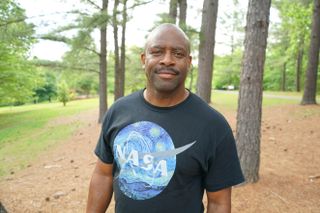One 'Strange' Organ: Astronauts Explain the Wonders of the Human Brain

Humans may not be the only species on Earth that evolved a brain, but we are the only ones who have used these complex organs to leave the planet. How did the human brain evolve to do things that our fellow brain-bearing creatures of Earth cannot?
Eight retired all-star astronauts discuss the beauty and complexity of the human brain, how it evolved and what it means to be an intelligent spacefaring species in a new episode of "One Strange Rock," which airs tonight (May 21) on the National Geographic Channel. The documentary series, hosted by Will Smith, tells the story of Earth from the perspectives of the former astronauts.
Tonight, the former NFL football-player-turned-astronaut Leland Melvin takes the lead to show viewers some of the incredible things that these wrinkled, 3-pound (1.4 kilograms) organs in our skulls are capable of doing. "It might look like a lump of Jell-O, but it's the most complex thing in our universe," Melvin says in the episode. "Inside there's a vast network with 100 trillion connections. That's more than the number of stars in the Milky Way."
Melvin may not be a neuroscientist — he holds a master's degree in engineering — but he has personal experience with the mysterious inner workings of the human brain. Before his first spaceflight, Melvin lost his hearing during a spacewalk simulation in NASA's Neutral Buoyancy Laboratory at the Johnson Space Center in Houston.
His spacewalk-training suit should have been equipped with a small foam block known as a "Valsalva," which allows astronauts to clear their ears by pressing their nose against it. Unable to relieve the pressure in his ears, Melvin continued with the training exercise – until he realized he couldn't hear anything.
"I was completely deaf," Melvin says in the show. But to his surprise, doctors couldn't find anything wrong with his ears after the accident. Rather, the problem was in his brain. "Somehow the connection between my brain and my ears had been severed — along with my chances of going to space," he says. Three weeks later, his hearing started to return. It took two years for him to fully recover, but he was finally able to fly on his first shuttle mission.
Melvin attributes his recovery not to any miracle of modern medicine, but to his brain's ability to adapt to these new circumstances. In the show, he says that the brain "over time can make adjustments to compensate for losses or changes," which is how he believes he was able to regain his hearing. "I'll never take my brain for granted again," Melvin says.
Get the Space.com Newsletter
Breaking space news, the latest updates on rocket launches, skywatching events and more!
Our complex brains can come in handy in many ways, some of which scientists don't fully understand. But why are humans the only species on Earth to be blessed with such intricate brains? If life existed on Earth for 3 billion years before any species evolved a brain, where did the first brains even come from? Melvin and his fellow space travelers will try to answer these questions in the penultimate episode of "One Strange Rock," which airs tonight (May 21) at 10 p.m. EDT/PDT (9 p.m. CDT).
Email Hanneke Weitering at hweitering@space.com or follow her @hannekescience. Follow us @Spacedotcom, Facebook and Google+. Original article on Space.com.
Join our Space Forums to keep talking space on the latest missions, night sky and more! And if you have a news tip, correction or comment, let us know at: community@space.com.

Hanneke Weitering is a multimedia journalist in the Pacific Northwest reporting on the future of aviation at FutureFlight.aero and Aviation International News and was previously the Editor for Spaceflight and Astronomy news here at Space.com. As an editor with over 10 years of experience in science journalism she has previously written for Scholastic Classroom Magazines, MedPage Today and The Joint Institute for Computational Sciences at Oak Ridge National Laboratory. After studying physics at the University of Tennessee in her hometown of Knoxville, she earned her graduate degree in Science, Health and Environmental Reporting (SHERP) from New York University. Hanneke joined the Space.com team in 2016 as a staff writer and producer, covering topics including spaceflight and astronomy. She currently lives in Seattle, home of the Space Needle, with her cat and two snakes. In her spare time, Hanneke enjoys exploring the Rocky Mountains, basking in nature and looking for dark skies to gaze at the cosmos.
